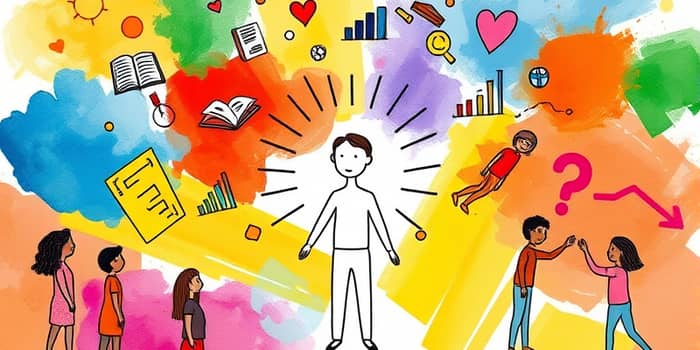
In a world obsessed with financial success, it can be tempting to believe that a larger paycheck automatically leads to a happier, more fulfilled life. Yet research consistently shows that income stops increasing happiness beyond a threshold of about $75,000–$90,000 per year. Beyond meeting basic needs and financial security, emotional wellbeing, meaningful relationships, and personal fulfillment depend less on money and more on self-knowledge and understanding spending habits, social consciousness, and deliberate decision-making.
This article explores why awareness—spanning financial, emotional, educational, and social dimensions—offers a far more powerful lever for lasting satisfaction, resilience, and societal progress than income alone. Drawing on the latest research, real-world examples, and practical steps, you will discover how cultivating awareness can unlock potential, enhance charitable giving, and bridge social divides.
Studies by psychologists and economists reveal an intriguing phenomenon: happiness rises with income up to a certain point but plateaus thereafter. For most individuals, once annual earnings surpass approximately $75,000–$90,000, additional income yields diminishing returns in day-to-day joy and life satisfaction.
This “income-happiness plateau” occurs because money can only satisfy external conditions—food, shelter, healthcare—but cannot guarantee deeper emotions such as purpose, connection, and gratitude. Individuals who focus solely on increasing income may overlook the internal growth and emotional intelligence that drives real contentment.
Awareness is multidimensional. It includes financial awareness, emotional awareness, social awareness, and self-awareness. Each dimension strengthens decision-making and life satisfaction.
Regardless of income level, individuals with high awareness consistently make better decisions. For example, those who track spending and set clear financial goals achieve greater stability than higher earners who spend impulsively. Similarly, emotional awareness fosters healthier relationships and effective communication, which contribute directly to life satisfaction.
Education is one of the most powerful pathways to increasing both individual and collective awareness. Beyond imparting knowledge, schooling and lifelong learning cultivate critical thinking, empathy, and an understanding of complex social and ethical issues. Higher educational attainment reduces poverty rates across generations, lowers maternal mortality by up to 29 percent, and fosters greater civic engagement and charitable giving.
These outcomes reflect how cultivating social, emotional, and digital awareness through education generates more sustainable progress than income alone. To illustrate the transformative power of awareness, consider the following comparison:
In 2023, Americans donated approximately $500 billion to charity. However, effective giving depends not merely on the size of donations but on the donor’s ability to identify high-impact causes, allocate resources wisely, and follow through with consistent support.
Movements such as effective altruism exemplify how awareness drives positive change. Donors leverage research, data, and expert opinion to maximize the benefit of each dollar, leading to innovations in global health, education, and poverty alleviation. This approach demonstrates that awareness allows individuals to make better philanthropic decisions than income alone.
Income inequality in the United States increased by about 20 percent between 1980 and 2016. Yet even as wealth gaps widen, individuals and communities can use awareness to foster solidarity and equitable progress.
By focusing on strategies that build collective understanding and empathy, societies can address root causes of inequality rather than treating symptoms through redistribution alone.
The internet era offers unprecedented access to information. Digital tools enable real-time tracking of spending and budgets, access to mental health apps that promote mindfulness, and platforms for community organizing and social advocacy. Content creators and organizations now emphasize educational narratives that empower audiences and build long-term trust.
Embracing these resources can amplify personal growth and communal impact, ensuring that awareness becomes a force-multiplier in every domain.
While financial ROI is straightforward, the returns from awareness are multifaceted. Enhanced emotional wellbeing, stronger relationships, greater community engagement, and informed decision-making yield benefits that span lifetimes. Surveys show people with high self-awareness report 30 percent greater life satisfaction and improved career success. Communities that invest in awareness-building witness reduced crime rates, higher educational attainment, and sustainable economic growth.
Investing time and attention in learning new skills, deepening emotional intelligence, and understanding societal challenges is personally rewarding and yields a collective return that far exceeds traditional financial metrics.
Developing greater awareness is a continuous journey. Practical methods include:
Over time, these activities compound into greater resilience, adaptability, and a sustained sense of purpose—benefits that money alone cannot purchase.
Ultimately, while income can alleviate immediate financial concerns, it is the cultivation of awareness—across financial, emotional, social, and intellectual dimensions—that empowers lasting fulfillment. By investing in learning, reflection, and community engagement, individuals can unlock their potential, drive measurable social change, and experience a deeper, more enduring happiness.
References













